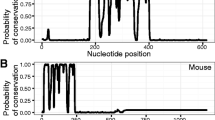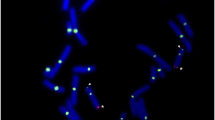Summary
A probe from a conserved motif of the SRY gene (sex-determining region Y), a prime candidate for the human testis-determinant, was hybridized to DNA from 23 species representing 5 vertebrate classes. Hybridization occurred in species with male or female heterogamety, in species with and without sex chromosomes and in those with temperature sex determination. Sex-specific signals were observed only in mammals. Conservation of sequences homologous with SRY through 400 million years of vertebrate evolution would indicate persistence of function. However, if SRY is the primary sex determinant in mammals, it is not clear that it has a similar function, or even one that is sex-related, in nonmammals.
Similar content being viewed by others
References
Berta P, Hawkins JR, Sinclair AH, Taylor A, Griffiths BL, Goodfellow PN, Fellous M (1990) Genetic evidence equating SRY and the testis-determining factor. Nature 348:448–450
Bull JJ, Hillis DM, O'Steen S (1988) Mammalian ZFY sequences exist in reptiles regardless of sex-determining mechanism. Science 242:567–569
Ferguson-Smith MA, North MA, Affara NA, Briggs H (1990) The secret of sex. Lancet 336:809–810
Ferreiro C, Medrano JF, Gall GAE (1989) Genome analysis of rainbow trout and sturgeon with restriction enzymes and hybridization with a ZFY gene derived probe to identify sex. Aquaculture 81:245–251
Gubbay J, Collignon J, Koopman P, Capel B, Economou A, Münsterberg A, Vivian N, Goodfellow P, Lovell-Badge R (1990) A gene mapping to the sex-determining region of the mouse Y chromosome is a member of a novel family of embryonically expressed genes. Nature 346:245–250
Jäger RJ, Anvert M, Hall K, Scherer G (1990) A human XY female with a frame shift mutation in the candidate testis-determining gene SRY. Nature 348:452–454
Jantzen H-M, Admon A, Bell SP, Tijan R (1990) Nucleolar transcription factor hUBF contains a DNA-binding motif with homology to HMG proteins. Nature 344:830–836
Koopman P, Gubbay J, Collignon J, Lovell-Badge R (1989) ZFY gene expression patterns are not compatible with a primary role in mouse sex determination. Nature 342:940–942
Koopman P, Münsterberg A, Capel B, Vivian N, Lovell-Badge R (1990) Expression of a candidate sex-determining gene during mouse testis differentiation. Nature 348:450–452
Page DC (1988) Is ZFY the sex-determining gene on the human Y chromosome? Philos Trans R Soc Lond [Biol] 322:155–157
Page DC, Mosher R, Simpson EM, Fisher EMC, Mardon G, Pollack J, McGillivray B, Chapelle A de la, Brown LG (1987) The sex-determining region of the human Y chromosome encodes a finger protein. Cell 51:1091–1104
Palmer MS, Sinclair AH, Berta P, Ellis NA, Goodfellow PN, Abbas NE, Fellous M (1989) Genetic evidence that ZFY is not the testis-determining factor. Nature 342:937–939
Sinclair AH, Berta P, Palmer MS, Hawkins JR, Griffiths BL, Smith MJ, Foster JW, Frischauf A-M, Lovell-Badge R, Good-fellow PN (1990) A gene from the human sex-determining region encodes a protein with homology to a conserved DNA-binding motif. Nature 346:240–244
Author information
Authors and Affiliations
Rights and permissions
About this article
Cite this article
Tiersch, T.R., Mitchell, M.J. & Wachtel, S.S. Studies on the phylogenetic conservation of the SRY gene. Hum Genet 87, 571–573 (1991). https://doi.org/10.1007/BF00209014
Received:
Revised:
Issue Date:
DOI: https://doi.org/10.1007/BF00209014




